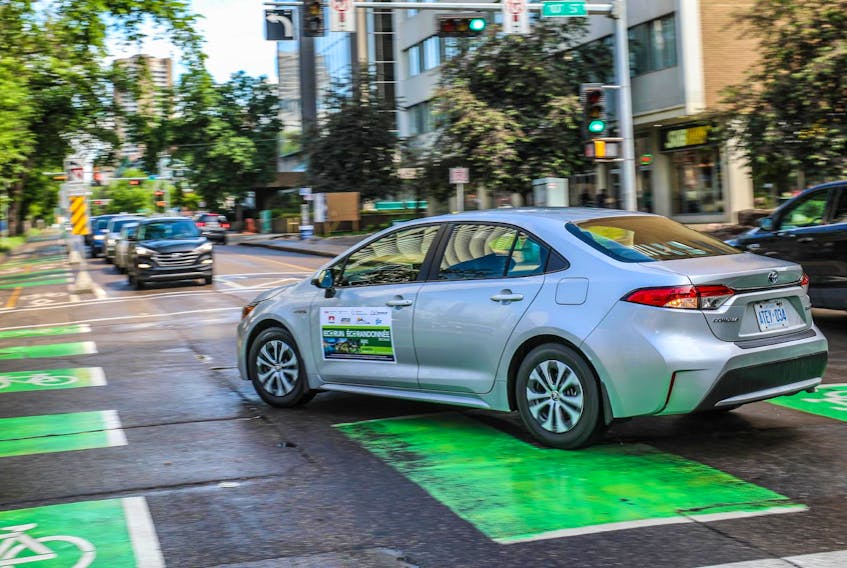Looking for a vehicle economical on fuel? Then look to EcoRun for some real life facts and figures to help you make your decisions.
EcoRun is an annual event organized by the Automobile Journalist’s Association of Canada (AJAC) that showcases a variety of eco-friendly vehicles as they are driven through city streets, freeways and rural highways.
EcoRun has been held in many locations in Canada, including Quebec, Ontario, British Columbia and New Brunswick; Alberta was the location for this year’s event.
Twenty vehicles from 12 manufacturers were driven by up to six drivers and the fuel economy of each driver and vehicle was recorded to see how they fared.
Each driver’s fuel economy was compared to the published fuel economy figures from Natural Resources Canada (NRCAN) and the most fuel efficient driver has the honour of receiving the “Green Jersey.” The results, photos and event schedule can be found at www.ajac.ca/ecorun.asp.
Vehicle powertrains included internal combustion gasoline engines, hybrid vehicles, plug-in hybrid vehicles, electric, diesel and even a hydrogen-fuelled vehicle, the Hyundai Nexo. Alberta proved to be a challenge for these vehicles as they travelled from the Prairies to the Mountains.
Starting in Edmonton in the beautiful riverside parks, the first leg of the journey took us down Alberta Highway #2 to Red Deer and the Alberta Sports Hall of Fame for a tour and time to charge the electric vehicles.
I drove the Infiniti QX50 with its variable compression 2.0-litre turbo engine for this leg and achieved 7.0 litres per 100 km for this leg, well below the 9.0-litre per 100 km rating of NRCAN. In fact, every driver on the event was able to better or equal the NRCAN fuel economy ratings on every vehicle in the event, showing that it is possible to drive economically no matter what you drive.
The key to driving economically is discipline. Avoid idling time, accelerate smoothly to speed with no fast acceleration, drive at the speed limit and coast to slow down when possible instead of using the brakes. Don’t pass other vehicles unless they are going well below the speed limit.
There are other ways to maximize your fuel economy. Make sure the tire pressures are set correctly. Combine several short trips into one longer one (an engine uses much more fuel during cold starts).
Pick routes that avoid other traffic so you can drive smoothly. Start longer trips in the early morning when wind speeds are usually low. Drive with your windows up on the highway.
Turn off the air conditioning when the weather outside is comfortable and use the fan and ventilation settings instead. All these techniques, if used all the time will save you a lot of money in fuel.
The second leg took us from Red Deer through rolling hills to Drumheller and the Royal Tyrrell Museum. This museum contains the worlds best exhibits of dinosaurs and is a major palaeontology research centre.
The Mazda3 Sport all-wheel drive I took on this leg achieved 5.1 litres per 100 km compared to NRCAN’s 8.2 litres per 100 km. This was a gasoline powered car with Mazda\s 2.5 litre SkyActiv engine.
The Third leg from Drumheller to Calgary was in Volvo’s XC60 hybrid SUV and I was able to match NRCAN’s 6.5-litre per 100 km. This took place under dramatic skies as major thunderstorms raced across the landscape.
High headwinds, rain so heavy I had to stop driving because I couldn’t see the road and hail showed how weather can affect fuel economy as I pulled into Calgary rush hour city traffic.
Day 2 of EcoRun would see mountains, more rain and challenges with charging stations for the electric vehicles, but that is also improving as Petro Canada introduced a new charging station in Canmore (Alberta) as a part of their initiative to provide coast-to-coast fast charging stations.
This network of charging stations will enable electric vehicles to travel longer distances easier and with peace of mind.
Overall, the 20 vehicles achieved an economy rating the equivalent of 4.7 litres per 100 km, beating last year’s record and showing that vehicle technology is contributing to better economy all the time.
Which vehicle achieved the best economy? That honour goes to the Hyundai Kona EV, with an average rating of 1.7 litres per 100 km equivalent.
Now that’s economy.
RELATED:









